MARIANI’S
Virtual
Gourmet
December
27, 2020
NEWSLETTER
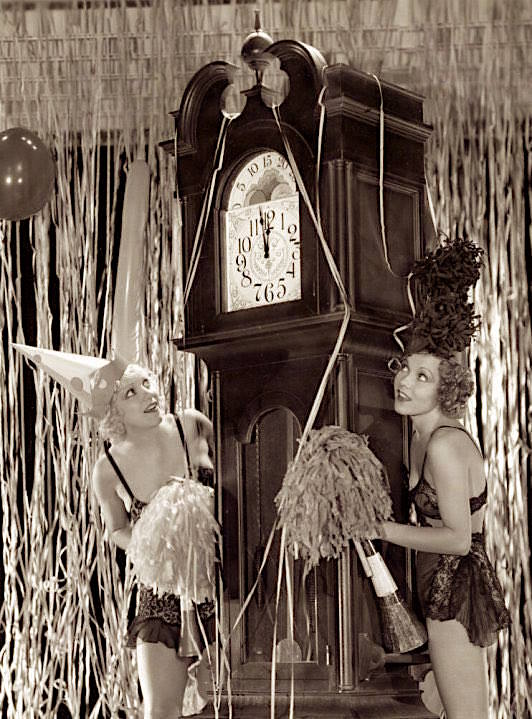 NEWSLETTER
NEWSLETTER
HAPPY NEW YEAR!
❖❖❖
IN THIS ISSUE
TURIN, HIDING IN PLAIN SIGHT
By John Mariani
NEW YORK CORNER
LOVE AND PIZZA
CHAPTER FORTY
By John Mariani
NOTES FROM THE WINE CELLAR
SO YOU WANT TO RUN A WINE TASTING
By John Mariani
❖❖❖
TURIN, HIDING IN PLAIN SIGHT
By John Mariani
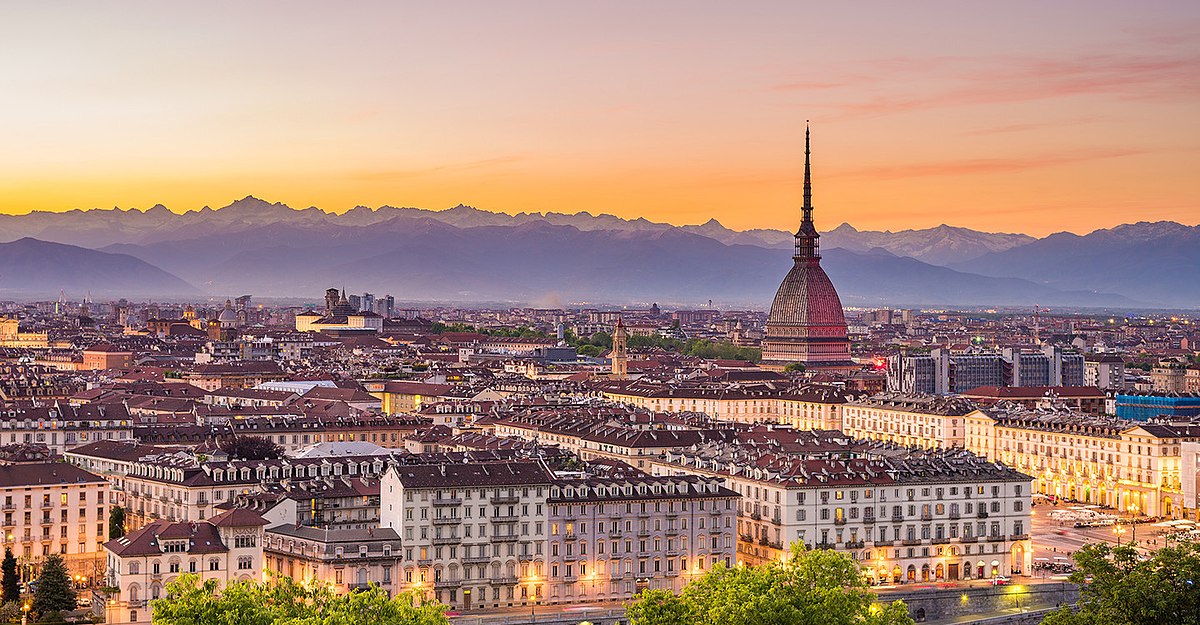
“Not even the
Italians know Turin!
They only know FIAT! FIAT! FIAT!”
So said
Michele, a spry, elegant,
elderly Turinese who took my wife and me for a cup
of rich, bittersweet coffee
and chocolate called a “capriccio”
at
the historic Caffè Baratti e Milano, opened in
1875 on Turin’s broad Piazza
Castello. We’d
met him just minutes
before on our search for the equally famous café
named Bicerin, only to learn
from Michele that it was closed on Wednesdays.
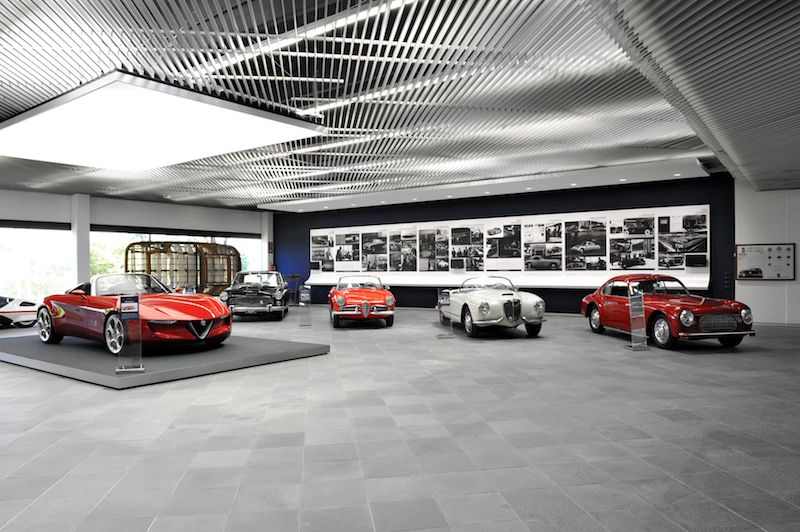 He
didn’t seem troubled by his
statement that the world outside of Piedmont,
including the rest of Italy, did
not regard his hometown as worth visiting, unless
it was to see the Automobile
Museum. “It
is not a bad thing not to
have so many tourists,” said Michele, who had a
salt-and-pepper beard and wore
an artfully thrown scarf around his shoulders. He
never gave us his last name
and seemed to have retired to the life of a
boulevardier known to every
bartender and barrista
in Turin.
He
didn’t seem troubled by his
statement that the world outside of Piedmont,
including the rest of Italy, did
not regard his hometown as worth visiting, unless
it was to see the Automobile
Museum. “It
is not a bad thing not to
have so many tourists,” said Michele, who had a
salt-and-pepper beard and wore
an artfully thrown scarf around his shoulders. He
never gave us his last name
and seemed to have retired to the life of a
boulevardier known to every
bartender and barrista
in Turin.
These days,
as Covid keeps the lid
on tourism in Italy, visitors are fewer than ever.
“Look around
you,” he said,
smiling. “Turin is never noisy, never crowded,
except”—his eyes rolled
back—“during those Winter Olympics! So we Turinesi
have our restaurants and
cafés all to ourselves most of the time.
Our Mercato sells every kind of food and
wine you could possibly want,
and the original EATaly is just a few kilometers
that way.” He waved his hand
in the general direction of the gargantuan food
market and restaurant complex
established in 2007 in the out-of-the-way Lingotto
district. He shrugged.
“Maybe I visit someday.” And then he was off,
saying he was meeting friends at
a trattoria whose name he neglected to share with
us.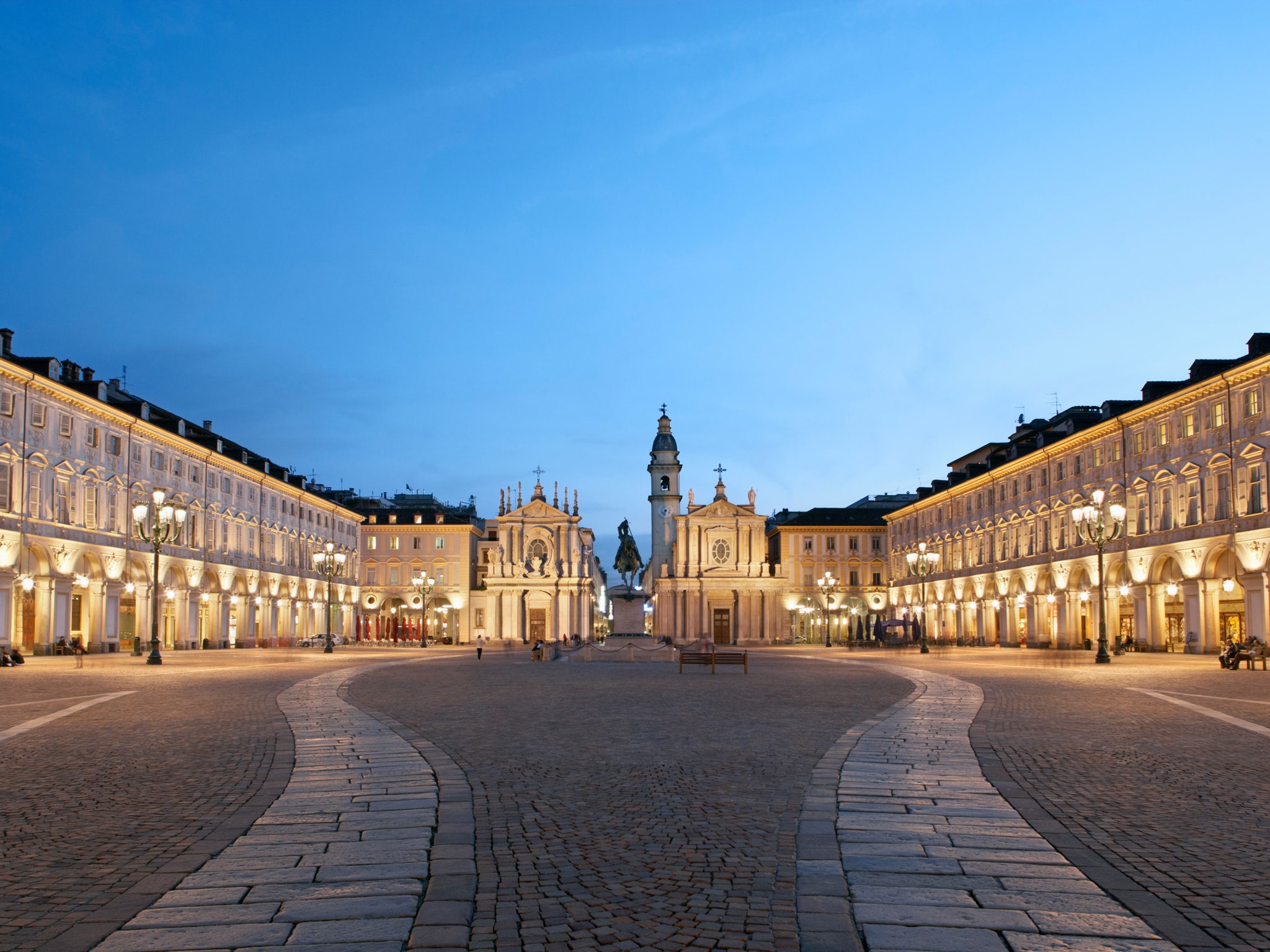
I must admit
that I, too, had
little knowledge of Turin, having only paid brief
visits to the city in the past
while attending a food conference or simply
passing through to tour the beauty
of the Piedmontese countryside and wine country,
where some of the region’s
most noted restaurants, like Combal.Zero in
Rivoli, Locanda del Pilone in Alba
and Delle Antiche Contrade in Cuneo, are located. My
earlier visits had, however, disabused me
of any thought that Turin was a drab,
self-absorbed northern industrial
city. It
is worth noting that director
Michelangelo Antonioni used Milan in “La Notte”
(1961), Rome in “L’Eclisse”
(1962) and Ravenna in “Il Deserto Rosso” (1964)—not Turin—to depict the deadening
effect of industrialization on
the soul of modern Italy.
On my last,
recent extended visit,
I found the heart of the city among the most
beautiful in Europe, justly famous
for its long, graceful series of arcades, the
grandeur of its vast piazzas, and
its stately and highly efficient grid pattern.
The Po River flows as majestically through
Turin as the Arno does
through Florence and the Tiber through Rome.
Fiat has, of course, dominated
and
buoyed Turin’s fortunes since 1899 (it still
produces 37 percent of Italy’s
GNP), but the Turinesi are quick to remind people
that their city was in fact
the first capital of an Italy unified in 1861
under Victor Emmanuel II, whose
Royal Palace (below), set in the huge
square entered from the broad Via Roma, is a
spectacular example of a 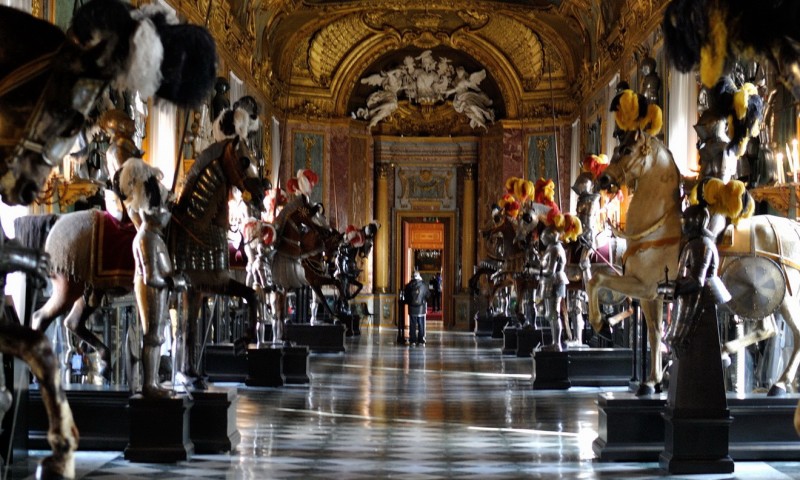 baroque
opulence intended to reflect the proud
independence of Piedmont, which only 50 years
earlier had been annexed by
Napoleon Bonaparte.
Upon invading Italy
in 1800, the young Corsican general faced 20,000
Piedmontese and 11,500
Austrians, but his tactical genius divided his
enemies and, in embarrassment,
King Victor Amadeus II ceded Piedmont to the
Corsican, who immediately
demolished Turin’s city gates and bastions and
renamed the Royal Palace as the
Imperial Palace—a decree that horrified and
humiliated the Turinesi. Napoleon’s
defeat at Waterloo in 1815 freed
Piedmont, whose power increased in the decades
leading up to 1861, when it
became the capital of the new Italy.
baroque
opulence intended to reflect the proud
independence of Piedmont, which only 50 years
earlier had been annexed by
Napoleon Bonaparte.
Upon invading Italy
in 1800, the young Corsican general faced 20,000
Piedmontese and 11,500
Austrians, but his tactical genius divided his
enemies and, in embarrassment,
King Victor Amadeus II ceded Piedmont to the
Corsican, who immediately
demolished Turin’s city gates and bastions and
renamed the Royal Palace as the
Imperial Palace—a decree that horrified and
humiliated the Turinesi. Napoleon’s
defeat at Waterloo in 1815 freed
Piedmont, whose power increased in the decades
leading up to 1861, when it
became the capital of the new Italy.
As an
imperial city, Turin’s
artistic treasures are exceptionally fine, all in
baroque wrappings. Although
there is no museum the equivalent of Florence’s
Uffizi or the Brera in Milan, the
Royal Palace itself—once residence of the powerful
Savoy dynasty, taken over by
the Italian government in 1946—is crammed with
notable works.
My wife and I were amazed at room after
room
of imperial salons,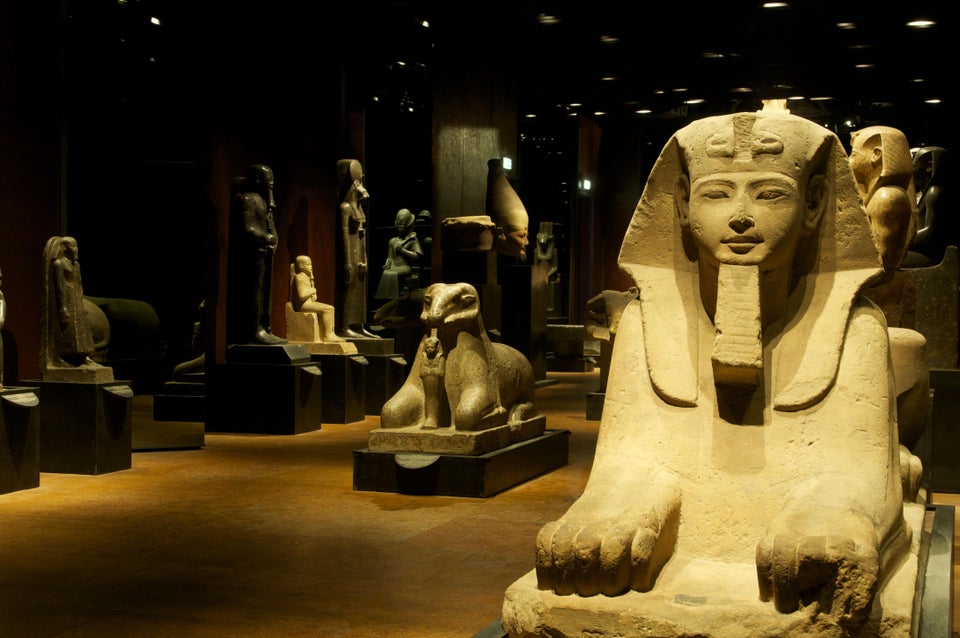 including
Queen Maria Theresa’s quarters, in every color of
marble, each with trompe l’oeuil painted ceilings,
and we were particularly
impressed with the palace’s collections of
exquisite tapestries and Chinese
porcelain.
including
Queen Maria Theresa’s quarters, in every color of
marble, each with trompe l’oeuil painted ceilings,
and we were particularly
impressed with the palace’s collections of
exquisite tapestries and Chinese
porcelain.
We toured
the city’s Egyptian
Museum at the Academy of Science (right),
considered one of the finest of its kind in
the world, on top of which sits the admirable Sabauda
Gallery (below), with works by
Bronzino, Veronese, Jan Van Eyck and Van Dyck. And
to gain a sense of the
unique way that Piedmontese royalty could actually
welcome the red-shirted
rebels of Garibaldi’s army, the 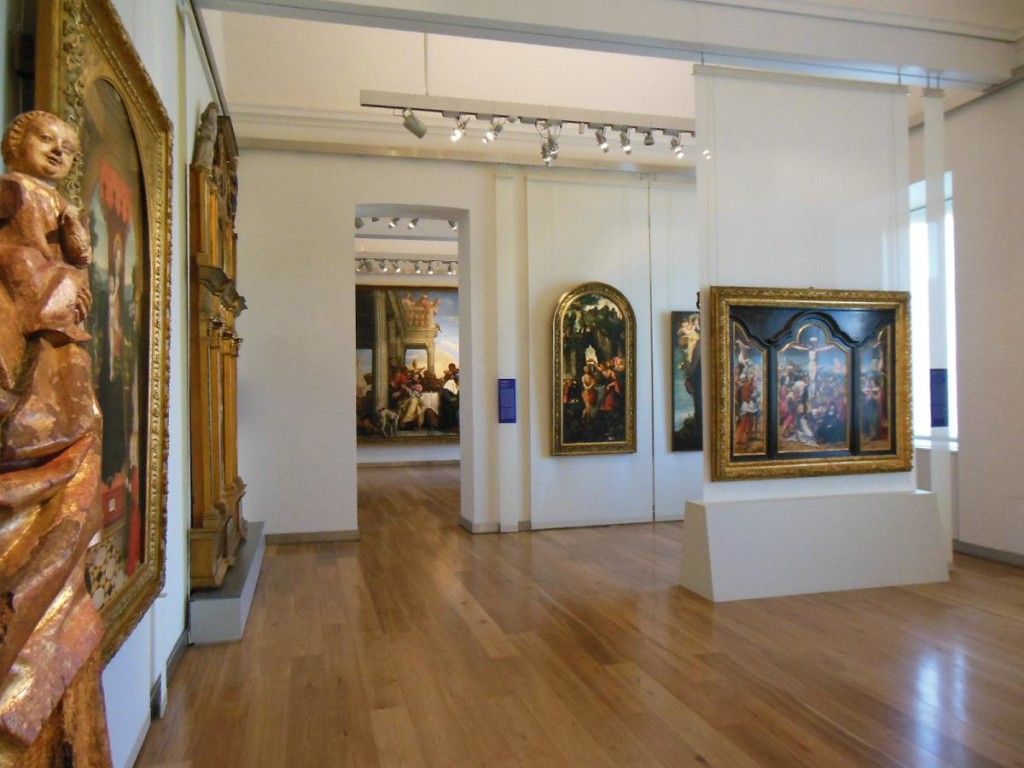 Museum
of the Risorgimento in the Palazzo
Carignano, where the first parliament of 1861 met,
depicts the region’s history
from the 19th century through Unification, and on
through two world wars.
Museum
of the Risorgimento in the Palazzo
Carignano, where the first parliament of 1861 met,
depicts the region’s history
from the 19th century through Unification, and on
through two world wars.
The
splendid Duomo of St. John the
Baptist, still home to the now wholly discredited
Shroud of Turin, is the
city’s only true example of pre-baroque
Renaissance architecture. And, as
everywhere else in Italy, there seems a church or
chapel on every block.
Uniquely
Turin, however, is its
National Museum of Cinema (below),
set inside a landmark 500-foot tower originally
designed as a synagogue in 1863 by Alessandro
Antonelli. We
wound from hall to hall and room to room
over five floors, flanked by flickering images of
early shadow cartoons and the
first primitive, silent efforts of Thomas Edison;
within the play of
chiaroscuro and expressionist lighting that evoked
“The Cabinet of Dr.
Caligari,” there are mini-theaters and long
corridors lined with huge movie
posters from every era. There is
also a
futuristic café-restaurant on the ground floor
whose starkness, color and light
could be a setting for a bar in “Star Wars” or
“Bladerunner.”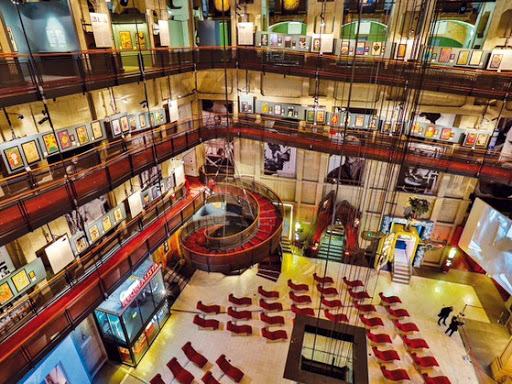
But if you ask a Turinese where his
city’s true artistic achievements lie, he might
well say they are in those
beautiful arched walkways that line miles of
streets and plazas throughout the
city center.
Of even height, woven
throughout the city so as to connect with one
another, the arcades were built
over the course of two centuries, principally as
shelter from Piedmontese
winters but also as showcases of banks and
boutiques, antique pharmacies and
food shops, and, more than anything else, cafés
and candy emporiums.
Look above their doorways and you see
stencils and carvings from the 18th and 19th
centuries. Their
façades are done in black marble, or
richly varnished mahogany, usually in the baroque
style but also in more
“modern” styles of Art Nouveau or Art Déco, and
they act very much like picture
frames for paintings.
One
of the most famous is Baratti & Milano
(1875; below), which bears the imperial
crest given it by the Vittorio II. The
King and Garibaldi toasted the Reunification at
Caffé Mulussano, later
relocated in 1907 and done in the sleek art deco
style of that period.
Litterateurs have long made Caffé Fiorio (1873)
their second home, and in his
day Fiat founder Gianni Agnelli passed his few
idle hours at Caffé Piatti
(1875). And while each has its secrets of coffee
making, it is likely that the
locally produced Lavazza coffee is the starting
point for the artfulness. While
café culture vitalized every large city
in Italy during the 19th century, none but Turin
brought it to an art form in
and of itself, where the cafes were extravagant
testimony to the luxurious
pleasures of taking time to sit, drink and talk.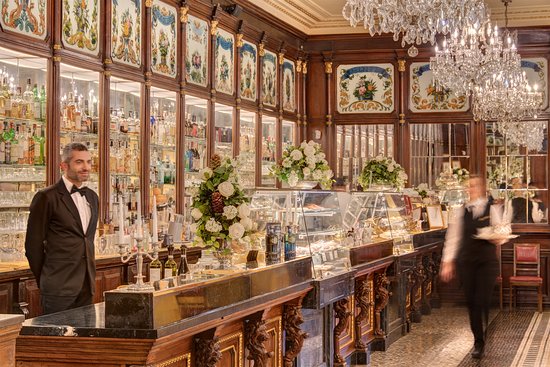 Indeed, it is the arcades that allow for
such
an extravagance of cafes barely imitated in
Venice’s Piazza San Marco.
Indeed, it is the arcades that allow for
such
an extravagance of cafes barely imitated in
Venice’s Piazza San Marco.
Through the spotless windows we saw
countless displays of the most
beautifully crafted chocolates, marzipan, and
sugared fritters in pastel
colors, pink paper, gold foil, arrayed in painted
tin boxes or set on lace
doilies. The
soft lighting inside is
never harsh, never low, imparting a Christmas
ornament’s appeal to the
confections every day of the year.
And
then
there is the aroma of the chocolate itself, almost
always commingled with
coffee set on the zinc or marble counters, where
white-coated barristas
grind, pack, adjust, steam,
fizz, and present their handiwork in a
manifestation of Turin’s deeply ingrained
coffee culture, richer than anywhere else in
coffee-obsessed Italy. The thunder
of the shuddering coffee machine, the clink of the
cups and saucers hitting the
bar and the tinkle of the little spoons in the
saucer never lets up. The barristas
pour a glass of Asti spumante for some, a tipple
of vermouth—created in Turin
by Antonio Benedetto Carpano in 1786—or a dark,
bittersweet amaro digestive for
others. A waiter delivers a slice of sugar-dusted
cake, covered with satiny
dark chocolate, with a filling of the
chocolate-and-hazelnut cream gianduja
that is also an invention of
Turin.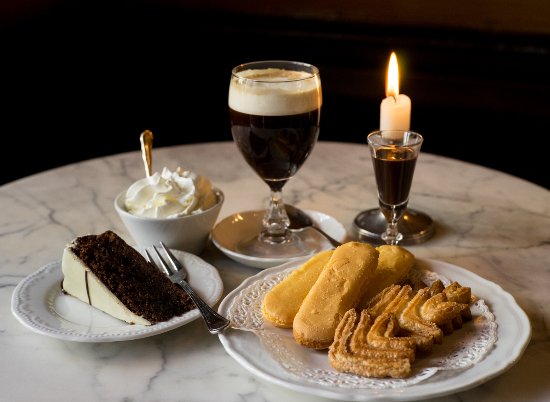
There
are many stories as to how gianduja
got its name, sometime in the 19th century, when
chocolate and coffee shops had
become the rage throughout Europe. Turin
tradition has it that the name derives from “Giovanni della doja” or “Gion
d’la duja”
(“John with a pint of
wine in his hands”), a popular commedia dell arte
marionette created by
Gioacchino Bellone di Raccongi first exhibited in
the city as of 1808.
Others contend it was named after di Oja, a
hamlet near Bellone’s hometown, and that the name
is really Giovanni di Oja.
 Whatever
the origin of its name, gianduja
made
a tremendous contribution to European chocolate
candy as we know it, and in
Turin, hazelnuts seem inseparable from chocolate
in any form.
Indeed, Turin is chocolate mad, and yet
another of its finest sweet ideas was bicerin,
a small rounded glass with a metal handle (from
which it gets its name) of hot
espresso, chocolate, and milk. Various
aficionados debate the origins of this totemic
Turinese concoction, though the
most widely accepted was that it was first made at
Caffè al Bicerin, which
opened on the Piazza della Consolata in 1763.
(Incidentally, the church across the piazza
has one of the most extraordinary
interiors in Turin.)
Whatever
the origin of its name, gianduja
made
a tremendous contribution to European chocolate
candy as we know it, and in
Turin, hazelnuts seem inseparable from chocolate
in any form.
Indeed, Turin is chocolate mad, and yet
another of its finest sweet ideas was bicerin,
a small rounded glass with a metal handle (from
which it gets its name) of hot
espresso, chocolate, and milk. Various
aficionados debate the origins of this totemic
Turinese concoction, though the
most widely accepted was that it was first made at
Caffè al Bicerin, which
opened on the Piazza della Consolata in 1763.
(Incidentally, the church across the piazza
has one of the most extraordinary
interiors in Turin.)
Like
the equally famous though not nearly so old Caffé
Sant’ Eustachio in Rome,
Caffè al Bicerin (above) is a
revered monument to coffee and chocolate, a dim,
fifteen-by-twenty-five-foot room with tiny marble
tables, candles that seem
votive, antique mirrors, dark red banquettes, wall
sconces, and old wooden
chairs. The cramped counter holds jars of bon bons
and chocolates, and the old
Faema coffee machine rumbles and roars like a Fiat assembly
line when the glasses of thick, semi-sweet
bicerins are made.
My wife and I entered
feeling like acolytes, privileged to sit at a tiny
table among an array of
Turinesi, many of them old men and women for whom
a morning bicerin is like
receiving Holy Communion, as a restorative against
the Piedmontese fog and
drizzle.
❖❖❖
By John Mariani
LOVE AND PIZZA
Since, for the time being, I am unable to write about or review New York City restaurants, I have decided instead to print a serialized version of my (unpublished) novel Love and Pizza, which takes place in New York and Italy and involves a young, beautiful Bronx woman named Nicola Santini from an Italian family impassioned about food. As the story goes on, Nicola, who is a student at Columbia University, struggles to maintain her roots while seeing a future that could lead her far from them—a future that involves a career and a love affair that would change her life forever. So, while New York’s restaurants remain closed, I will run a chapter of the Love and Pizza each week until the crisis is over. Afterwards I shall be offering the entire book digitally. I hope you like the idea and even more that you will love Nicola, her family and her friends. I’d love to know what you think. Contact me at loveandpizza123@gmail.com
—John Mariani
To read previous chapters go to archive (beginning with March 29, 2020, issue.
LOVE AND PIZZA
Cover Art By Galina Dargery
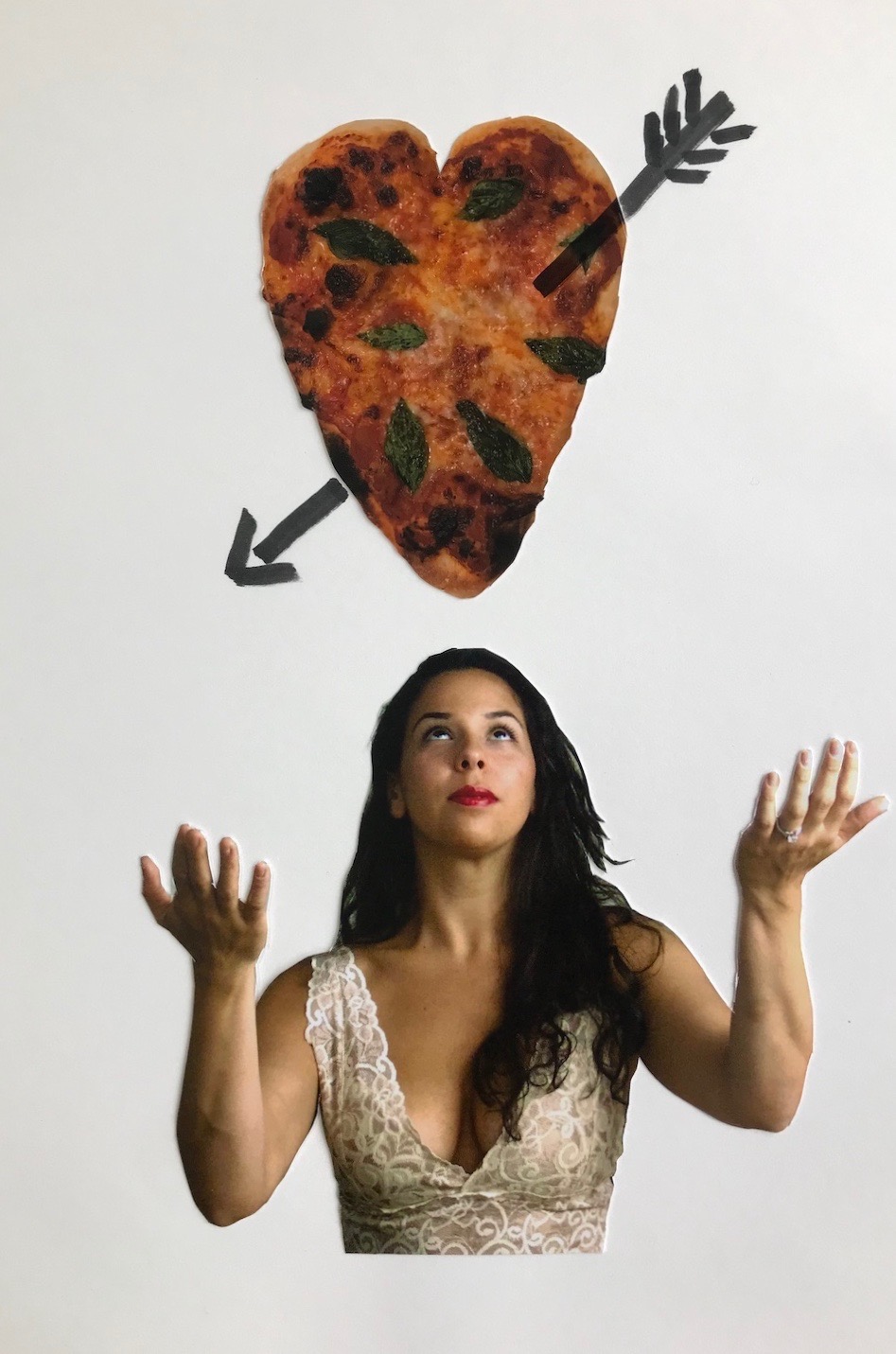
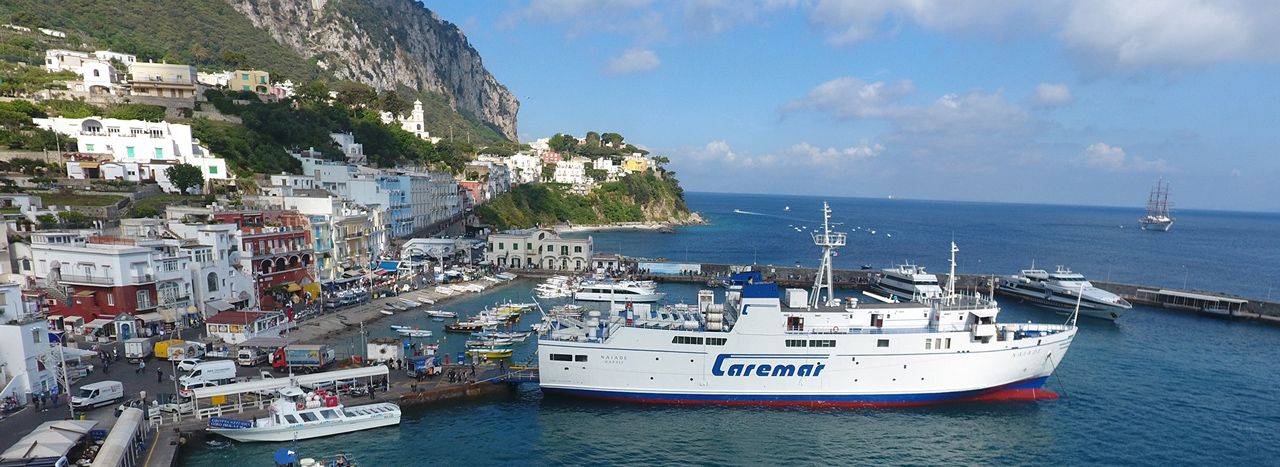
The
next morning Marco arrived on time and the
couple took a taxi to the dock in
time to catch t he
9:10 fast ferry to Naples, arriving at ten
o’clock.
Marco found a taxi driver he knew and
they
set off, in full view of the Royal Palace of
Naples and into the maze of
streets that on Sunday morning were quiet and
easy to navigate. Past
the Archaeological Museum they turned
onto Via Santa Teresa then the Via Miano and
arrived at the Museo di
Capodimonte (below), located in a 17th
century Spanish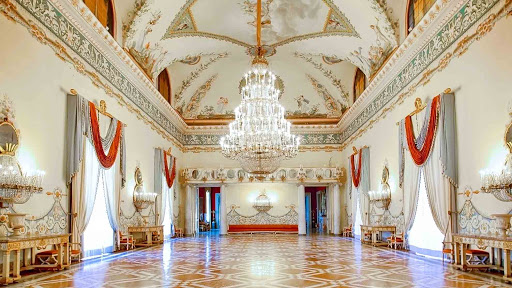 Bourbon
palace.
Bourbon
palace.
When
French troops entered the city in 1806 much of
the artwork not already removed
to safety was looted, and upon the troops
leaving in 1815, King Ferdinand
restored and restocked the palace, which only
became a full-fledged national
museum as of 1950.
Once
inside, Marco, holding Nicola’s hand, walked
swiftly through rooms that
retained the architectural grandeur of its time
as a royal residence, then
slowed down as they entered the Galleria
Nazionale, where they would find an
extensive collection of the Neapolitan School
artwork as well as paintings by
Raphael, Titian, Masaccio, El Greco and
Caravaggio.
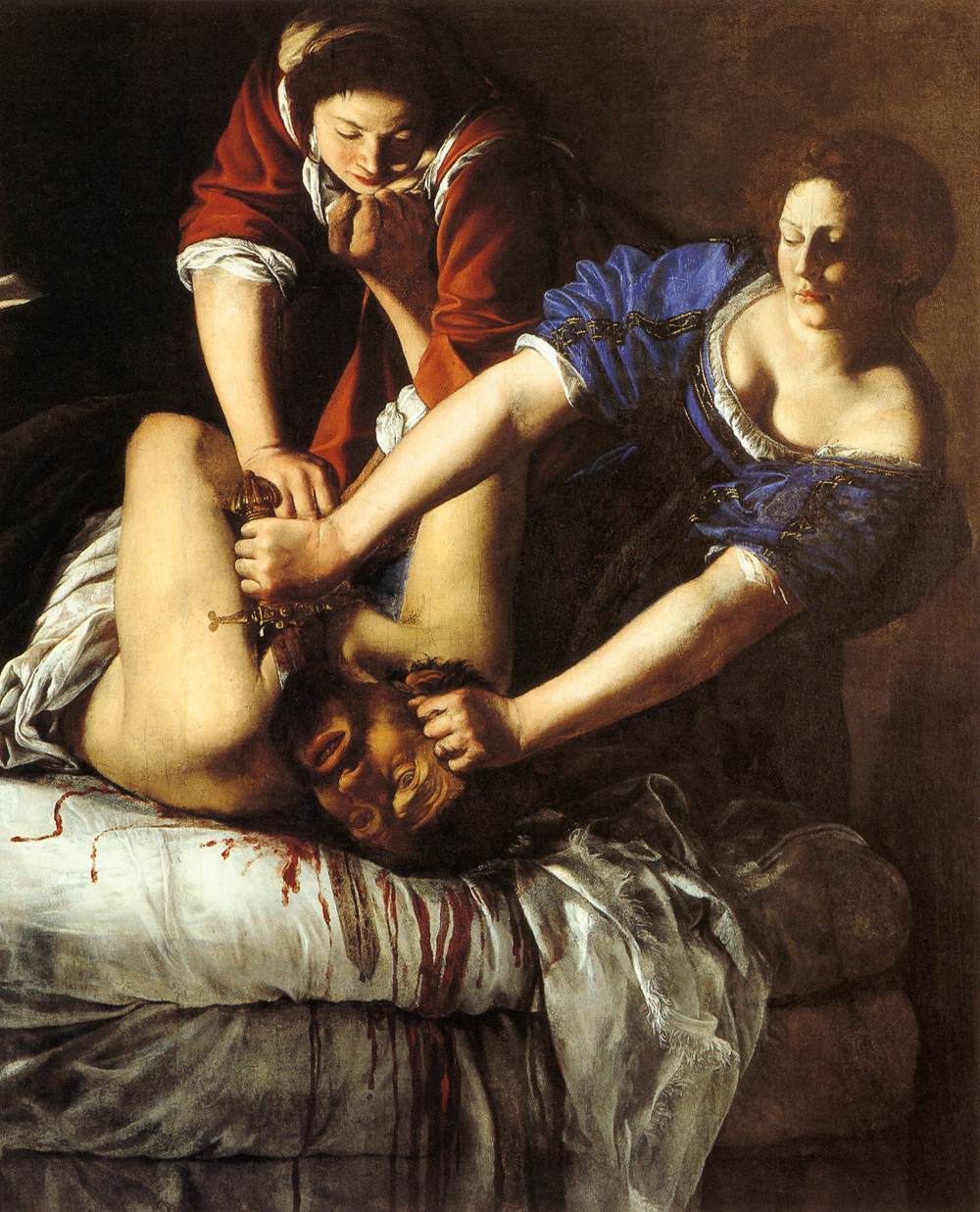 Marco
explained
that Caravaggio was born in Milan and his use of
dramatic light and
dark—chiaroscuro—had enormous influence on
Neapolitan artists during his short
time in Naples.
Marco
explained
that Caravaggio was born in Milan and his use of
dramatic light and
dark—chiaroscuro—had enormous influence on
Neapolitan artists during his short
time in Naples.
“They
were called the caravaggisti,”
said
Marco, who pointed out their similarities of
style in paintings whose subjects
were always more theatrically posed than the
sublime renderings of the same
subjects by northern artists. “Unfortunately,
many
of them died during a plague epidemic in 1756,
and the movement quickly
dissipated. Ars longa,
vita brevis.”
Nicola,
remembering her Latin, repeated in English, “Art
is long, life is short.”
Nicola
was in awe of so many masterpieces she was
unaware existed by artists she’d
never heard of.
She could, of course,
see the influence of other artists from other
regions, but that was true
everywhere in Europe during the Renaissance,
when travel to Italy was requisite
for any serious young painter.
Marco
moved his fingers in front of various paintings,
telling Nicola that the
Neapolitan painters could never hide their
deep-seated sense of tragedy, which,
of course, was rife in religious art.
“They
reveled in what was horrifying, always conscious
of death and decay, but they
suffused it all with a bravura of light and
color that forced the viewer to
respond both emotionally and spiritually.
They painted a skull with the same skill
they brought to a portrait, and
the more dreadful the martyrdom, the more
sublime they made the saint look.”
Nicola
nodded at what Marco told her and said, “You’d
make a terrific art teacher.”
“Please,”
Marco laughed.
“I make little enough
money as it is.”
After
perusing several more galleries, Marco said, “We
have only scratched the
surface. You
must come back to Napoli
and stay for a while.”
Nicola
assented, saying, “I must admit you're right
about the Neapolitan School. It’s
really been neglected 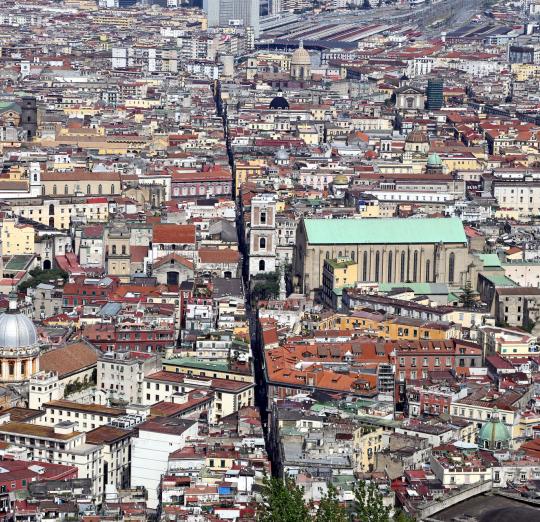 by the
professors.”
by the
professors.”
“But
now,” Marco said, clapping his hands, “I am
starving. Do you want to have the
best pizza in Napoli?”
Nicola
smiled broadly and said, “I couldn’t imagine
anything I’d rather have right
now. I
never had time to get breakfast.”
“Okay,
we go then.
I take you to my favorite
place, in Spaccanapoli, the old town. It’s very
close by.”
Nicola
had heard the name Spaccanapoli—“split
Naples”—for it cut like a black ribbon
in a straight line through the most ancient part
of the city center, and though
it is lined with churches and urban palaces, its
reputation as being dirty,
cramped and dangerous was well known among
tourists.
It
was now past one o’clock, and the city was only
beginning to emerge from the
revelries of Saturday night and the requisites
of attending Mass, which would
be followed by family dinner. The
wash
that usually hung on clotheslines like wet
banners had mostly been taken in,
and, except for the narrowness of the street, it
all reminded Nicola of where
she was born and grew up.
Nicola,
intentionally, slipped into the little true
Neapolitan dialect she knew,
saying, “Nun e’ assai diverse a comme addo
stong e casa a New York. This is
not very different from where I live in New
York.”
Marco’s
eyes widened and he said, “Ah, Nicola, so you
know Neapolitan! That’s wonderful.
How about we speak it over lunch?”
Nicola
had bitten off more than she could
linguistically chew and replied, “It won’t
be easy for me, but I’ll try.”
“Brava!
Okay, I promise I won't correct
you. Ah, here we are. Pizzeria
Scugnizzo.”
To
say the pizzeria was a hole in the wall was high
praise, for a door fit for
only one person at a time to pass through led to
a room with just four tables,
a board for a bar, and a pizza oven in the rear,
tended by a very large man who
rarely turned towards the guests.
“That’s
Angelo,” whispered Marco in English.
“People say he was ordained by God to
make pizzas and has no other
skills whatsoever.”
Another
man, who didn't need to walk a step to greet the
couple, welcomed Marco like an
old friend, then commented on Nicola being so
beautiful. “Si,” said Marco, “Essa e’
bella e assai intelligente. E’
n’
scolaro d’artista! E tene o’ sangue Napulitane
dinte ‘e vene. She is very
beautiful and very intelligent. A scholar of
art! And she has Neapolitan blood
in her veins!”
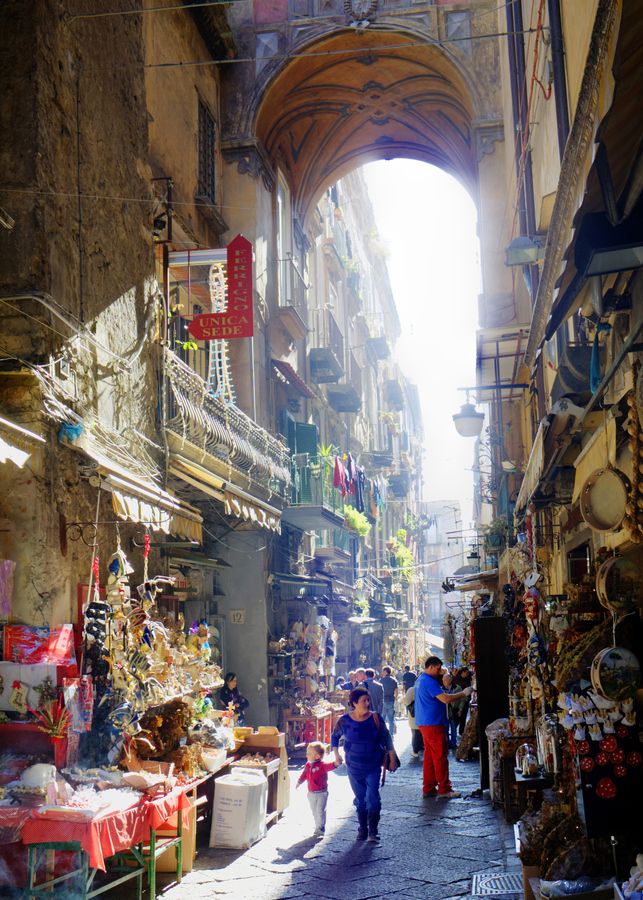 This
revelation caused the man to clap his hands
together and say, “Tenimme ‘o
mazzo scassato oggi. Comme te
chiamme, Nenne’? Then
we are all
lucky today. What is your name, Signorina?”
This
revelation caused the man to clap his hands
together and say, “Tenimme ‘o
mazzo scassato oggi. Comme te
chiamme, Nenne’? Then
we are all
lucky today. What is your name, Signorina?”
“Nicola
Santini.”
“Santini!
A faccia mia, allo simme
pariente.
Ce stanne certi Santini tra i
pariente miei. O meglie zie, me pense.
Ah, maybe we are related. There
are some Santinis somewhere among my ancestors.
A great uncle, I think.”
Nicola
was having a hard time understanding the
dialect, but she heard the same sounds
she’d grown up with and felt far more at home
than she ever did in Milan.
A
pizza alla
margherita was ordered,
two glass tumblers were placed on the table
along with a bottle of red wine,
without a cork.
Nicola was breathing in
the smoky aroma of the place, watching Angelo
make his ten millionth pizza as
if it were a special event, and then, four
minutes later, two steaming pies
with their melted mozzarella, crushed tomatoes
and basil set on a bubbling,
charred crust came to their table.
Raising
his eyes to heaven, Marco announced, “Stu
mumento e’ sacro! Nicola Santini sta pe’ da ‘o
primme muorzeche a pizza ‘e
Angelo!” This is a sacred moment! Nicola
Santini is about to have her first
taste of Angelo’s pizza!”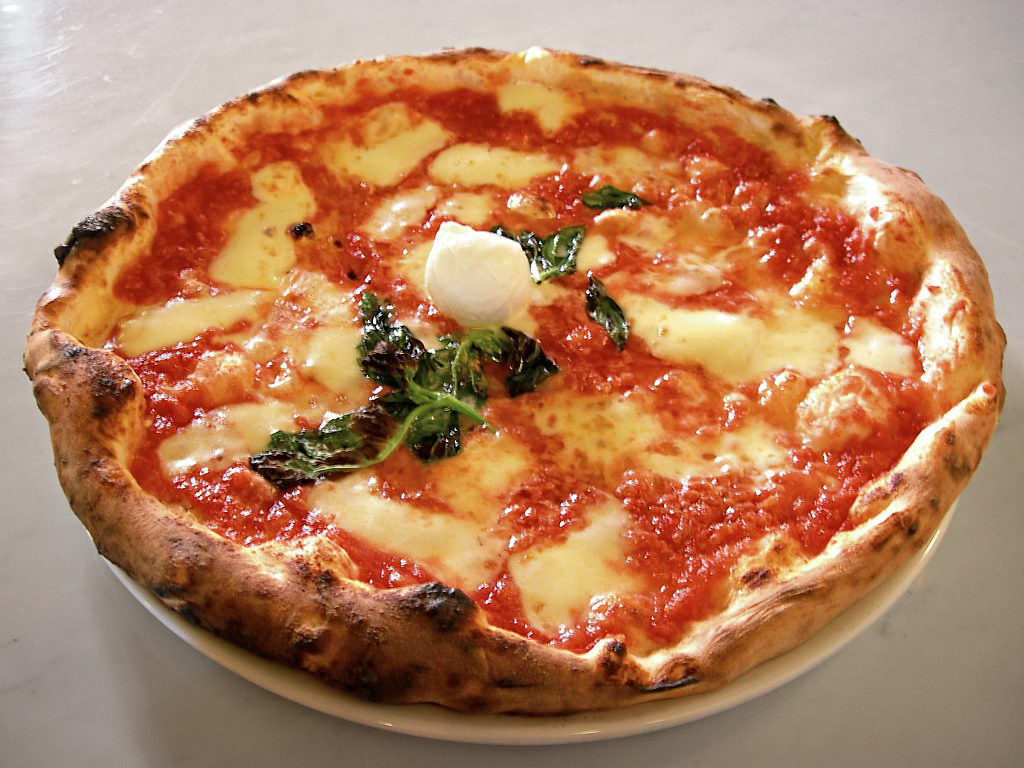
Nicola
smiled, cut off a piece from the pie, blew on it
and placed it on her
tongue. Suddenly
her mind ran riot with
the memories of all the pizzas she’d ever
eaten—in New York, in Milan—and how
this pizza came as close to the one made at Alla
Teresa as it could possibly
be. It
was different from Paper Moon’s,
not as thin, not as crisp, with a flaccid middle
that Joe Bastone would
applaud. The
melding of the ingredients,
the taste of the yeast, and the aroma of the
barely cooked basil all coalesced
into a moment of revelation to Nicola, who now
felt herself linked forever and
more intimately than ever before to these people
who surrounded her.
The
pizza was the savory link, but the sense that
she knew how good this pizza was,
just as she knew Italian art, meant
that all that had happened to her in the past
year seemed part of a destiny
that led her to this tiny room in Spaccanapoli.
Nicola
turned to Marco, gave him a huge kiss on the
cheek, and said, “I am deliriously
happy at this moment, Marco!”
The
waiter,
even Angelo, turned around and applauded. More
wine was poured, more pizza was
consumed, and life was very good for everyone
that day.
By John Mariani
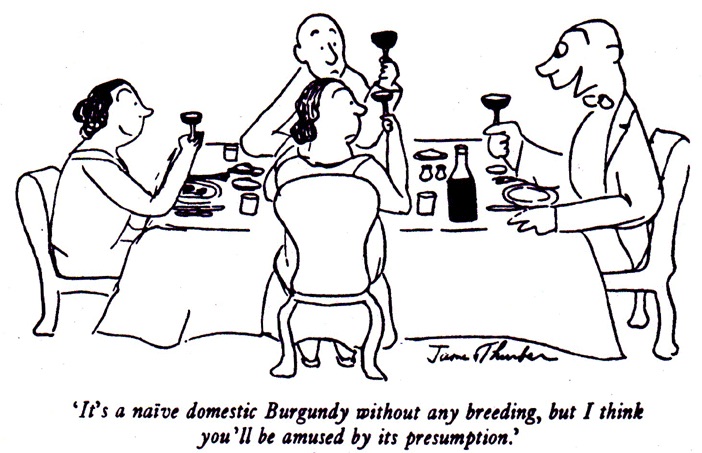
 Such winespeak can get pretty
pretentious
if not downright silly. Yet
the increased interest in wine among Americans has
made the once-unimaginable
idea of a wine tasting a capital reason for a good
party. I
say unimaginable because such a social
event once seemed to be a connoisseur’s game of
one upmanship.
Today, though, gathering friends to taste
and
discuss wines has become one of the most convivial
ways to get together and far
less exclusionary and competitive than a bridge
club or poker night. So, when the pandemic lifts
in 2021, a lot of people will be dying to get
together and taste wines in such a convivial
exercise.
Such winespeak can get pretty
pretentious
if not downright silly. Yet
the increased interest in wine among Americans has
made the once-unimaginable
idea of a wine tasting a capital reason for a good
party. I
say unimaginable because such a social
event once seemed to be a connoisseur’s game of
one upmanship.
Today, though, gathering friends to taste
and
discuss wines has become one of the most convivial
ways to get together and far
less exclusionary and competitive than a bridge
club or poker night. So, when the pandemic lifts
in 2021, a lot of people will be dying to get
together and taste wines in such a convivial
exercise.
The idea of simply assembling a bunch of wines to taste without any focus can, however, become tiresome. On the other hand, bringing together people who may know little or nothing about wine and people who think they know everything about wine is very much like inviting people from Madagascar to a Super Bowl party. It gets. . . awkward.
So, here are a few guidelines to holding a wine tasting for people who have a general knowledge and interest in wine rather than those who consider discussion of Ph levels and vine trellising fit conversation at a party.
The first rule of thumb is not to serve too many wines—six is an ideal amount. Fewer is a sipping, not a tasting. Ten becomes a chore.
Next, you should decide if you’ve going to taste the wines blind, that is, without revealing their names, not in an
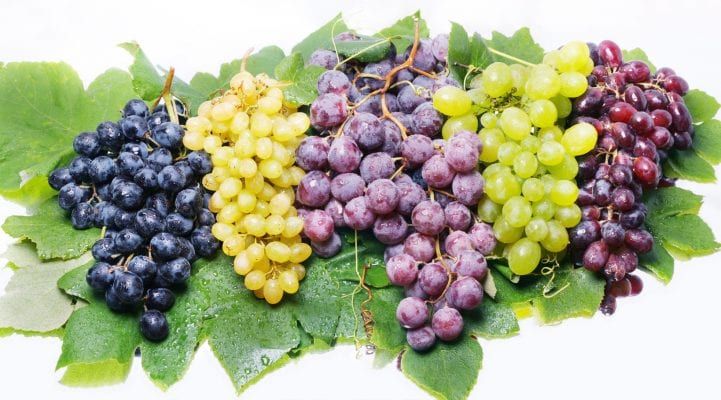 effort to fool or
embarrass anyone but to
judge their character according to people’s likes
rather than mere familiarity
with a famous name.
You might feature
wines from a particular region, like Tuscany or
New Zealand, Napa Valley or
Sicily. Or by varietal grape, like cabernet
sauvignon, grenache or
chardonnay. “A
vertical tasting is when
you taste the exact same wine from the same
producer but in different
vintages,” says Gabrielle Waxman, former wine
director for Galatoire’s
restaurant in New Orleans. “A horizontal tasting
is when you taste wines from
the same vintage or the same grape varietal but
from different producers.”
effort to fool or
embarrass anyone but to
judge their character according to people’s likes
rather than mere familiarity
with a famous name.
You might feature
wines from a particular region, like Tuscany or
New Zealand, Napa Valley or
Sicily. Or by varietal grape, like cabernet
sauvignon, grenache or
chardonnay. “A
vertical tasting is when
you taste the exact same wine from the same
producer but in different
vintages,” says Gabrielle Waxman, former wine
director for Galatoire’s
restaurant in New Orleans. “A horizontal tasting
is when you taste wines from
the same vintage or the same grape varietal but
from different producers.”If so, you should cover the bottles with a paper bag to hide the labels. The bag should also disguise the shape of the bottle because some varietals, like pinot noir and riesling, are always sold in specifically shaped bottles. Then, number the bags and reveal the labels only after all are tasted.
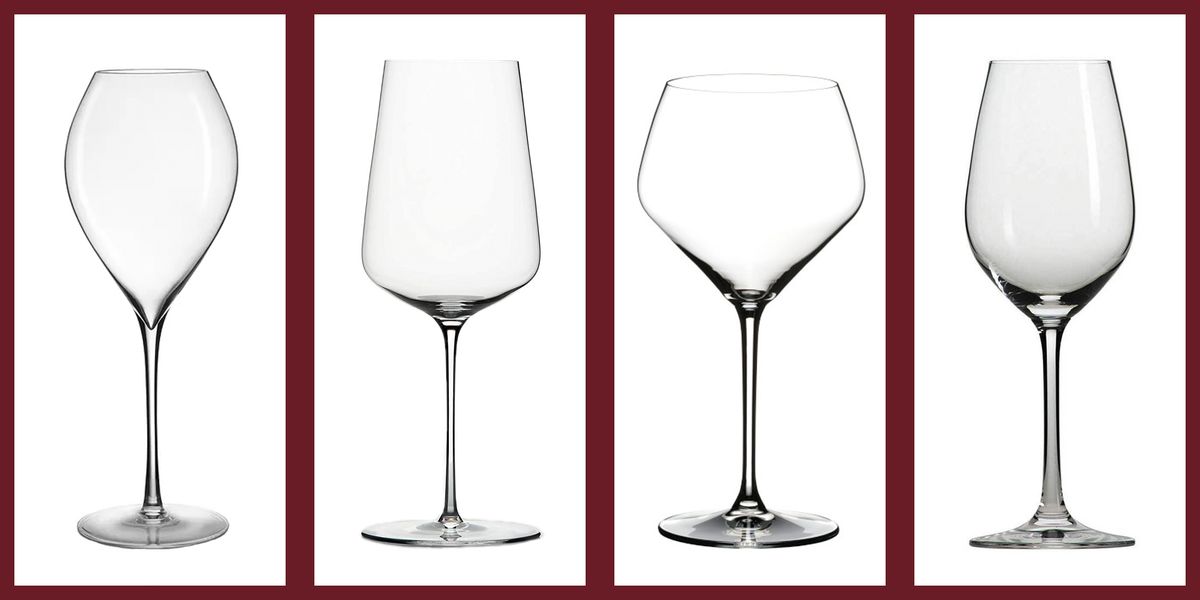 As to
glassware, connoisseurs
usually stick with a single shape, even though
restaurants may serve different
varietals in different shapes, like Alsatian wines
in green-stemmed glassware.
As to
glassware, connoisseurs
usually stick with a single shape, even though
restaurants may serve different
varietals in different shapes, like Alsatian wines
in green-stemmed glassware.The best type to use is a thin wineglass in which a four-ounce pour fills about half the glass. This allows for swirling and sniffing the aroma of the wine, itself a point of discussion.
If you are tasting the wines before dinner, have plain water and crackers or bread available to restore your palate wine after tasting the wine. Salted butter on the cracker is also an excellent way to intensify the flavors of the wine, because salt
 and fat intensify
flavors.
and fat intensify
flavors.If you are serving the wines with dinner, keep the food simple so that the wine remains the focus. Simply grilled red meat goes well with big reds, while cheeses or seafood without a spicy sauce bring out the best in whites, and vice-versa.
You might also consider a Champagne tasting, since there are so many labels, styles and price levels available in the U.S. now. You go by colors, from yellow to golden to rosé, and some have floral bouquets, others are more robust and toasty. You may also try them by grape varieties: blanc de blancs are made with all white chardonnay grapes, while blanc de noirs are made from red pinot noir. There are also vintage and non-vintage, and premium prestiges cuvées.
As host, you should try to stir discussion, without any momentous pronouncements. To set the atmosphere, it’s a good idea to begin with a memorable quotation from a great person, like Thomas Jefferson, who said, “No nation is drunken where wine is cheap” or Lord Byron, who wrote, “Let us have wine and women, mirth and laughter,/ Sermons and soda-water the day after.”
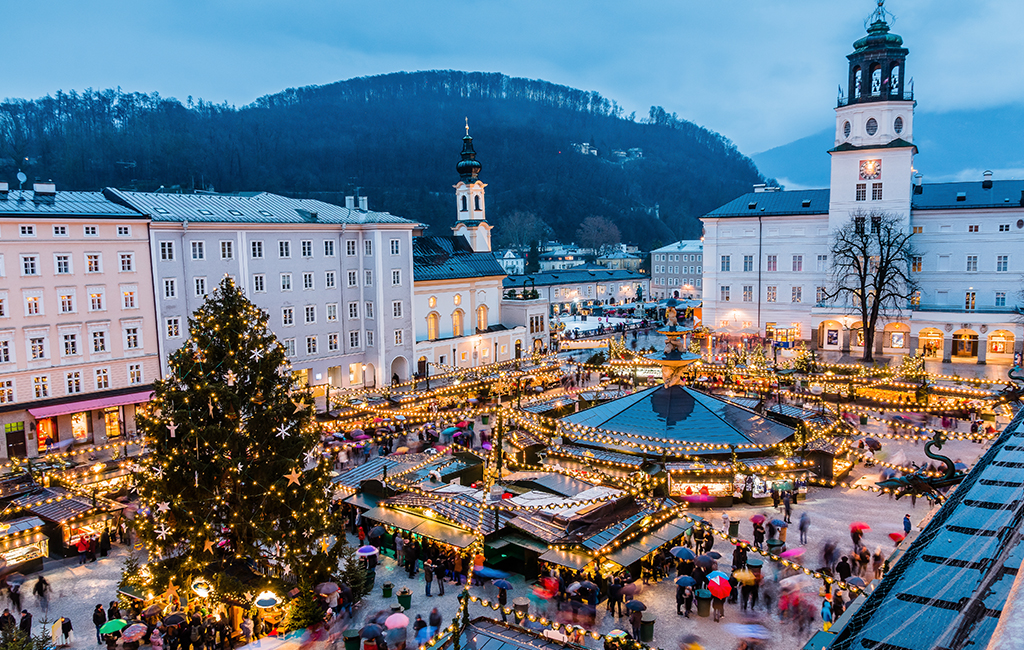
The travel site VISIT CROATIA: Tasteful Croatian Journeys is featuring Salzburg and Munich, Germany, and Prague, Czech Republic but none in Croatia.
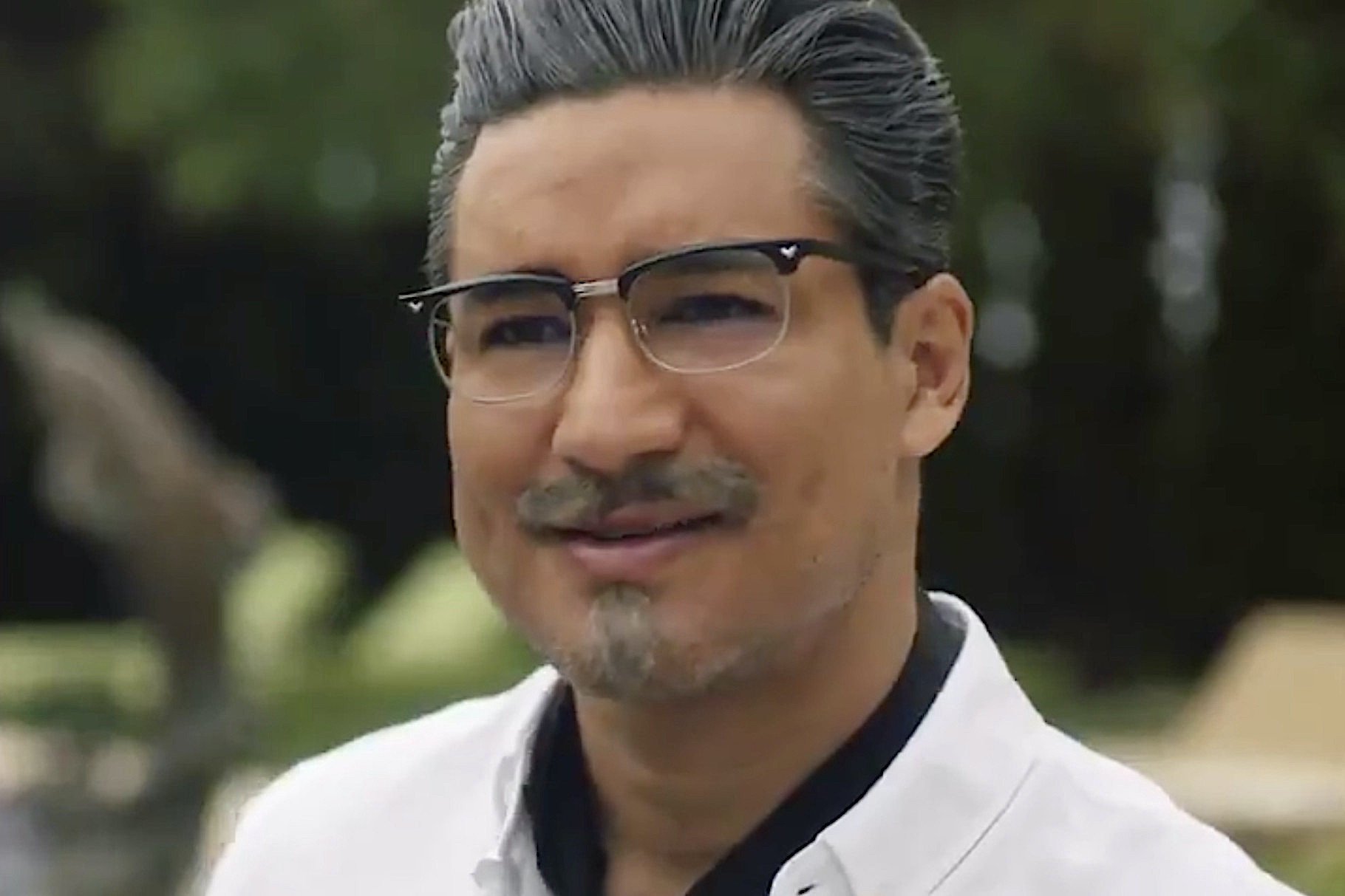
MAN OF THE YEAR:
Mario Lopez as Col. Sanders of KFC.
❖❖❖
Sponsored by

Any of John Mariani's books below may be ordered from amazon.com.
 The Hound in Heaven
(21st Century Lion Books) is a novella, and
for anyone who loves dogs, Christmas, romance,
inspiration, even the supernatural, I hope you'll find
this to be a treasured favorite. The story
concerns how, after a New England teacher, his wife and
their two daughters adopt a stray puppy found in their
barn in northern Maine, their lives seem full of promise.
But when tragedy strikes, their wonderful dog Lazarus and
the spirit of Christmas are the only things that may bring
his master back from the edge of despair.
The Hound in Heaven
(21st Century Lion Books) is a novella, and
for anyone who loves dogs, Christmas, romance,
inspiration, even the supernatural, I hope you'll find
this to be a treasured favorite. The story
concerns how, after a New England teacher, his wife and
their two daughters adopt a stray puppy found in their
barn in northern Maine, their lives seem full of promise.
But when tragedy strikes, their wonderful dog Lazarus and
the spirit of Christmas are the only things that may bring
his master back from the edge of despair. WATCH THE VIDEO!
“What a huge surprise turn this story took! I was completely stunned! I truly enjoyed this book and its message.” – Actress Ali MacGraw
“He had me at Page One. The amount of heart, human insight, soul searching, and deft literary strength that John Mariani pours into this airtight novella is vertigo-inducing. Perhaps ‘wow’ would be the best comment.” – James Dalessandro, author of Bohemian Heart and 1906.
“John Mariani’s Hound in Heaven starts with a well-painted portrayal of an American family, along with the requisite dog. A surprise event flips the action of the novel and captures us for a voyage leading to a hopeful and heart-warming message. A page turning, one sitting read, it’s the perfect antidote for the winter and promotion of holiday celebration.” – Ann Pearlman, author of The Christmas Cookie Club and A Gift for my Sister.
“John Mariani’s concise, achingly beautiful novella pulls a literary rabbit out of a hat – a mash-up of the cosmic and the intimate, the tragic and the heart-warming – a Christmas tale for all ages, and all faiths. Read it to your children, read it to yourself… but read it. Early and often. Highly recommended.” – Jay Bonansinga, New York Times bestselling author of Pinkerton’s War, The Sinking of The Eastland, and The Walking Dead: The Road To Woodbury.
“Amazing things happen when you open your heart to an animal. The Hound in Heaven delivers a powerful story of healing that is forged in the spiritual relationship between a man and his best friend. The book brings a message of hope that can enrich our images of family, love, and loss.” – Dr. Barbara Royal, author of The Royal Treatment.
 |
The Encyclopedia of American Food and Drink by John F. Mariani (Bloomsbury USA, $35) Modesty forbids me to praise my own new book, but let me proudly say that it is an extensive revision of the 4th edition that appeared more than a decade ago, before locavores, molecular cuisine, modernist cuisine, the Food Network and so much more, now included. Word origins have been completely updated, as have per capita consumption and production stats. Most important, for the first time since publication in the 1980s, the book includes more than 100 biographies of Americans who have changed the way we cook, eat and drink -- from Fannie Farmer and Julia Child to Robert Mondavi and Thomas Keller. "This book is amazing! It has entries for everything from `abalone' to `zwieback,' plus more than 500 recipes for classic American dishes and drinks."--Devra First, The Boston Globe. "Much needed in any kitchen library."--Bon Appetit. |
"Eating Italian will never be the same after reading John Mariani's entertaining and savory gastronomical history of the cuisine of Italy and how it won over appetites worldwide. . . . This book is such a tasteful narrative that it will literally make you hungry for Italian food and arouse your appetite for gastronomical history."--Don Oldenburg, USA Today. "Italian
restaurants--some good, some glitzy--far
outnumber their French rivals. Many of
these establishments are zestfully described
in How Italian Food Conquered the World, an
entertaining and fact-filled chronicle by
food-and-wine correspondent John F.
Mariani."--Aram Bakshian Jr., Wall Street
Journal.
"Equal parts
history, sociology, gastronomy, and just
plain fun, How Italian Food Conquered the
World tells the captivating and delicious
story of the (let's face it) everybody's
favorite cuisine with clarity, verve and
more than one surprise."--Colman Andrews,
editorial director of The Daily
Meal.com. "A fantastic and fascinating
read, covering everything from the influence
of Venice's spice trade to the impact of
Italian immigrants in America and the
evolution of alta cucina. This book will
serve as a terrific resource to anyone
interested in the real story of Italian
food."--Mary Ann Esposito, host of PBS-TV's
Ciao
Italia. "John Mariani has written the
definitive history of how Italians won their
way into our hearts, minds, and
stomachs. It's a story of pleasure over
pomp and taste over technique."--Danny Meyer,
owner of NYC restaurants Union Square
Cafe, The Modern, and Maialino.
|
 |
 |
 |
 |
 |
 |
 |
 |
 Everett Potter's Travel Report:
Everett Potter's Travel Report: 
 Eating Las
Vegas JOHN CURTAS has been covering
the Las Vegas food and restaurant scene
since 1995. He is the co-author of EATING LAS
VEGAS – The 50 Essential Restaurants (as
well as the author of the Eating Las
Vegas web site: www.eatinglasvegas.
He can also be seen every Friday morning as
the “resident foodie” for Wake Up With the
Wagners on KSNV TV (NBC) Channel 3 in
Las Vegas.
Eating Las
Vegas JOHN CURTAS has been covering
the Las Vegas food and restaurant scene
since 1995. He is the co-author of EATING LAS
VEGAS – The 50 Essential Restaurants (as
well as the author of the Eating Las
Vegas web site: www.eatinglasvegas.
He can also be seen every Friday morning as
the “resident foodie” for Wake Up With the
Wagners on KSNV TV (NBC) Channel 3 in
Las Vegas.
MARIANI'S VIRTUAL GOURMET
NEWSLETTER is published weekly. Publisher: John Mariani. Editor: Walter Bagley. Contributing Writers: Christopher Mariani,
Robert Mariani, Misha Mariani, John A. Curtas, Gerry Dawes, Geoff Kalish,
and Brian Freedman. Contributing
Photographer: Galina Dargery. Technical
Advisor: Gerry
McLoughlin.
If you wish to subscribe to this
newsletter, please click here: http://www.johnmariani.com/subscribe/index.html
© copyright John Mariani 2021

